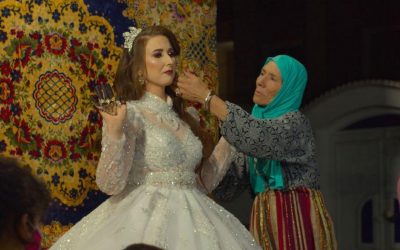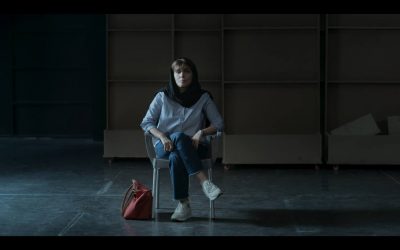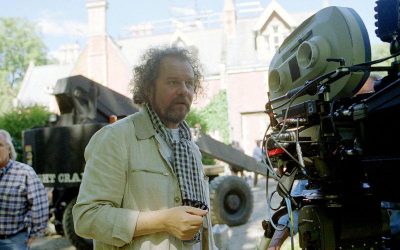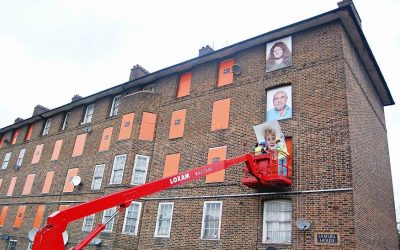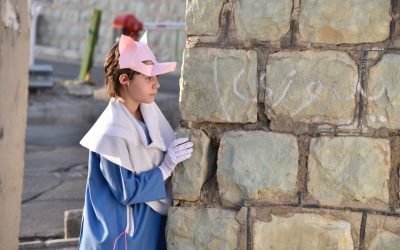An Analysis of Five Short Films by Young Female Filmmakers from Iran, Turkey, Lebanon, and Palestine to be soon showcased at the 32nd Raindance Festival 2024 in London, curated by Mania Akbari.
Authors: Pegah Pezeshki and Mania Akbari
Trauma, body, and geography constitute intricate and intertwined concepts with which contemporary humanity grapples for a modicum of security. In five short films directed by women, exploring the geographies of Iran, Turkey, Palestine, and Lebanon, we witness displaced and homeless individuals who feel insecure in their geography, home, and society, carrying historical traumas within a hierarchical regional and global power structure. In a sense, their bodies serve as continuations of the memories of their ancestors and their geography and land. It’s a kind of historical geographical turmoil and disorientation that now shapes us. In these five short films, we encounter vivid imagery and creative narratives spoken
by the young women of these regions
1. For the oppressed (women, queers, the poor, immigrants), what does it mean to be “at home”? Breaking the illusory image of “home” as a place of security and love, and as a refuge from the “street,” is the intersection point of these five films. The film “21 Weeks” directed by Nasrin Mohammadpour, without ever showing the house, reveals its lack of safety for women. The story follows a woman in Iran who wants to end her pregnancy voluntarily. She seeks to control whether she becomes a mother or not. Forced to undergo the procedure in an unprofessional and unsanitary clinic, she then walks the streets with a bag containing the remains of the fetus, looking for a place to bury it. Yet, the street is rife with visible and invisible police presence. We, like the woman anxiously navigating alleys and streets, know that anyone passing by might become an agent of repression. The woman, carrying the remnants of her self-terminated pregnancy in a bag within her purse, disrupts the city merely by walking. But what is crucial is the relentless presence of “home” in this unsafe city. Her phone keeps ringing with her husband yelling at her, demanding to know where she is and what she’s doing. “What the hell are you doing?” The exceptional cinematography and the brilliant performance of the young actress convey this despair and anxiety to the viewer. The home not only completes the insecurity of the oppressive street but is itself the very embodiment of that insecurity. The home is the reason for the woman’s wandering steps in streets that threaten her with potential assaults at every turn. And indeed, she is attacked—when she tries to find a place to bury the “remains,” she is deprived of even this final choice. A motorcyclist snatches her bag, with everything inside it, including that piece of her that was separated from her body. The extent of insecurity is such that even if you end an unwanted pregnancy in secret, the piece taken from your body can be stolen in an act of utter desperation. The woman, in her struggle to reclaim control over her body, continues resiliently despite her wounds.
In an interview with Redcut, the director explains: “The reason for choosing and emphasizing this topic stems from the historical background of this challenge for women. Since the beginning of criticism and intellectual movements advocating women’s right to abortion and body autonomy, several historical periods have passed. Unfortunately, this issue remains one of the most crucial concerns for women in countries where this natural and inherent right is denied by political regimes, moral values, and patriarchal culture.

Pegah Pezeshki, Writer
In response to Redcut’s question about the body as a symbol of refuge and home in the film, the director states: “The body in this film symbolizes the refuge and home of a life that, within a patriarchal structure, lacks the means and readiness to give life to another. The woman, through her self-willed abortion, seeks to reclaim her bodily autonomy. We are confronted with the concept of insecurity and the lack of a home, which should be a place of safety and the right to choose one’s existence. What does the concept of body and home security mean to you in this film? She continues: Drawing from Turner and my own lived experience as a woman, social worker, and filmmaker in the realm of women’s issues, I want to address this question. The politicization of women’s bodies has become more central to political and cultural activities than ever before. Regulating bodies has become a focal point of governmental oversight and control. It is a fundamentally political and strategic entry point. Historically, from primitive societies to industrial ones, laws, and programs have been enacted to increase and control the population without considering women’s fundamental personal rights—whether they are ready or not for motherhood and reproduction. Initially, the management of women’s bodies was politically driven, then influenced by their husbands, society, and ultimately, the women themselves. Addressing the security, status, and degree of a woman’s ownership over her shared living space or home follows the same pattern.
2. In the film “Canary in a Coal Mine,” directed by Dewan Kaoukji from Lebanon, we see another form of breaking and the security of home. This time, the home is initially someone else’s—a house belonging to an aunt and her husband who are away on a trip and have temporarily entrusted it to Anis. However, the house, in which Anis is a stranger from the start and whose lengthy rules of residence are sent by her aunt in a voice message she violates, quickly becomes a place of intrusion. The film portrays a humorous narrative of two very inept burglars breaking into the house. Yet, Anis (a stranger in the house from the beginning) now fully embraces the role of another thief to save her life. It’s as if the breaking of the house’s doors pushes her to the extreme of the role she had from the start—someone who cannot afford a home and is merely a temporary resident in someone else’s house. She plays the role of a thief along with them and moves all the belongings to a warehouse outside the city. However, the burglars lock Anis in the warehouse with the stolen items. It’s as if Anis is dehumanized by the burglars and reduced to an object, left alongside the stolen goods in the warehouse. The body is so controlled and imprisoned by the power structure that it feels as though it has been stolen (like the objects in the warehouse) and stripped of individual identity. The next morning, Anis discovers that the “thieves” are actually the police officers of the area, the very ones she intended to report the burglary to. There’s something interesting about the expression on Anis’s face when she confronts these police officers. She almost smiles. Although part of this smile stems from the film’s humor, there is also a trace of relief and liberation in it. “Liberation” because what was hidden is now revealed. Now the agent of repression in the street (the police) is the same agent of intrusion into the home, the one for whom walls and locks become necessary. The one whose presence creates the illusion of home security and makes seeking refuge in it seem essential.

Mania Akbari, Writer
Redcut in conversation with the film’s director: What matters in your short film is the unsafe home existing in an unsafe land. It somewhat alludes to plundering and stealing our history, documents, and historical memory by thieves living in stolen lands and geographies, and the homes that are vulnerable? Absolutely! The story is very much a metaphor for the crimes committed by the state over the last few years. In 2019, we had an economic crisis in Lebanon that was created by a severely corrupt government and left the country entirely bankrupt, deteriorating economic stability, and soaring inflation rates. The population couldn’t access their savings or assets in the bank and families were devastated. The situation left people with no trust in the government and no sign of hope for their future. I was very affected by these changes personally. I don’t feel safe in my home today, and coping with these changes has been challenging. However, I find inspiration in people’s coping mechanisms and their resistance to control. Lebanese people have historically been through years of civil war and a great deal of social, political, and economic instability, which has left them very resilient to change. And their biggest coping mechanism is to actively look for new opportunities and possibilities for change. Home is very important to us, and while we may not have enough power to make a change, our perspective on home is something that is in our power.
3. It is in this process of conflict with the body and home that the woman in the story “There is no Place for You – directed by Ceyda Aşar ” escapes from home to nature. A woman’s feet, which have traces of tree roots with them from the beginning, move further away from “being at home” with each step. The roots become more prominent and the female body becomes more alien from home. Throughout the film, the woman does not say a word. The only silent observer is the house that the man wants to “sell” to her, to make her believe that it is a safe and suitable place. But this time, the man is not in the traditional role of the husband, who is supposed to provide/enforce the woman to be “at home”. Rather, he is a corporate man who publicly offers the house as a commodity. But the woman’s body rejects the house more and more until she leaves the house without saying a word. When she leaves the house, she seems to leave the imagination of the man and the camera; He can no longer be seen/shown except as an impossible oneness with nature. The woman who leaves the house, the woman who does not “buy” the house, seems to disappear because her imagination is otherwise impossible.
Ceyda, in response to Redcut’s question, The role of women and home in this film formed in your mind as if we women are always homeless! A home symbolizes a historical sense of security. The home embodies stories that encompass our body and soul. She replied: I believe that one of the major problems of the world today is a violent confrontation between masculine & feminine forms of existence. Especially in my country, Turkey, this is very obvious and can be observed very easily by a stranger as well. This is the result of the current political situation. “Homeless women” is a metaphor. The people who are perceiving the world within a female point of view are homeless in a society and world that is all designed only by mind, excluding body, soul, heart and nature. The houses we live in, how we built our cities, all the painful class conflicts that we create, the economy and the system in general… All of these things are the instruments of the masculine domination. The female form searches for itself in the depths of its existence, unlike the masculine form which is always eager to be under the spotlight, always hurrying, talking too much, always categorizing things, and always quite sure of what is secure and what is not. Nevertheless, the feminine form is never satisfied with the given patterns, social patterns, economical patterns, environmental patterns, etc … She feels boredom and tries to find a way out. This deep search leads her to nature. I am hesitating while choosing the word “nature” because I don’t really mean it literally. I tried to imply all of these things in an allegorical way. Nature is a feminine form of existence. She has the ability to combine with nature. She culminates in the tranquility of unification and feels free in the end. After all, if we want to reach out to the core of the story, this is a film about the rebellion of a female character and her search for freedom.
4. In the film “The Long Walk,” directed by Sonia Sanjari, death, life, and imagination dictate the absence from home. The body, as a place and time, becomes a vessel through which the world can take on human form, revealing its personal history in the social and cultural soil that shapes its roots and relationships with others and the world. The body is not something separate from its surrounding world. The film begins with death. A man and a woman are conversing on a motorcycle, with the man speaking in long sentences and the woman giving brief and disinterested affirmations. Moments later, the motorcycle crashes. The man dies immediately, and the woman continues with an injury. Through abstract imagery, visual aesthetics, and delicate framing, the film reflects the woman’s mundane and mournful daily life. A drop of water slowly slides down a glass; the footsteps of another person in the house; the ringing of a phone; and most prominently, the wound on her face. Gradually, through this monotonous mourning, the wound on the woman’s body heals. She soon accepts a friend’s invitation and, contrary to custom and the insistence of her host, does not go inside for the party. Outside the house, during a two-player game with the host, they enter a dreamlike space where, with special glasses, they see their surroundings filled with luminous fireflies. The film, which begins with death, ends with countless lights.
In response to Redcut’s question, “The emphasis on the wound on the woman’s face is a reminder of the trauma that occurs with the death at the beginning of the film,” Sonia Sanjari, the director of the film, explained: “Life, with its resilience, continued in the woman’s body. The close-up shots of the woman’s face, the focus on the wound, and the precise and appropriate use of objects around her moved the narrative from a realistic storytelling state to a complex abstract state of bodily wounds. We encounter a lone, wounded woman with a body that has been in an accident. Why was it that the male character was killed at the start of the story, while the female character continued with her wounds and gave hope to another man, symbolized by the distant fireflies?” She responded: “Since this story is very personal and based on my traumas, I couldn’t imagine it any other way. For me, this story can only be told from a woman’s perspective. That’s why the woman had to stay and the man had to go. Because each event inflicts a wound on our psyche, I thought it was a good idea to make these wounds tangible, and witnessing their healing process was like therapy for me. No matter how deep the wounds are, they eventually heal, and you come to terms with the marks they leave on your body and soul. Looking at or touching them no longer hurts. They become a part of you, and sometimes you even grow to love them. In a way, ‘The Long Walk’ emphasizes that the concept of the ‘body’ is an imagination; but an imagination that operates culturally and is alive.”
5. In The Battle of Empty Stomachs – Directed by Diana Al-Halabi Based on research and interviews with Palestinian hunger strikers and asylum seekers, this absurd but realistic film depicts a dialogue between the director and his mother tongue that centers on one question: do we What do we know about hunger? This film is a poetic and musical tribute to those who suffered from the consequences of famine and migration; To the Palestinians whose hunger strike goes beyond the deafening silence of the colonial world.
In Foucault’s thought, the subject and their body are shaped through the mechanisms of surveillance and internalized disciplinary systems. Perhaps the most significant consequence of this condition is the alienation, enslavement, and fragmentation of the subject and their body. It seems Foucault proposes two interconnected solutions for liberating the subject from this state: “constant resistance” and “truth-telling.” By this, Foucault calls on us to engage in perpetual resistance against the relations of knowledge/power/truth, not only in the external world but also within ourselves. In the film “The Battle of Empty Stomachs,” with its brilliant cinematography and symmetrical framing, we encounter such conditions. We see people who resist and fight for change with empty stomachs, where their stomachs depict a state of “political hunger.
The director tells Redcut about this: This film isn’t about my personal history, my past traumas, or the pain I’ve endured. Despite coming from a working-class background, I’ve never experienced hunger in my life, except during fasting as a Muslim child. That is stated in the film when my “mother tongue” asks me “What do you know about hunger?” and I respond “I once knew about fasting.” I started the film with this dialogue to make it clear that, if I am speaking about hunger, that doesn’t mean I claim to know what it is. This film as I mentioned earlier is the result of my 2-year research about famine and hunger strikes that, if juxtaposed, we can see how politicized our digestive system is. A siege inflicted by states can cause famine to subordinate a nation, and a political prisoner can fight an unjust system by staging a hunger strike. These two types of hunger are political, and so is hunger that is due to dire economic situations. Throughout my research, I conducted interviews with two Palestinian hunger strikers to delve deeper into the subject matter. Every insight they shared was delicately woven into the fabric of the film. The scene where the prison guard removes the salt from the table symbolizes the practice in Israeli prisons of confiscating salt when a prisoner declares a hunger strike since they know that even the smallest amount of salt is crucial for a hunger striker to prevent rapid deterioration of their empty stomachs. The coffee scene was a reference to how Israeli prisons use all the methods possible to force a hunger striker to break their strike without force-feeding them. Making coffee in large quantities, or even barbequing in the prison is one of their methods. It is a way to torture a hunger striker by stimulating their appetite. Ribhi Karajeh, one of the Palestinian hunger strikers I spoke with, expressed that the chill induced by hunger can sometimes be more challenging than the hunger itself. Consequently, Israeli prison guards strip away blankets from hunger strikers, adding another layer to their torment.
The Palestine situation was the point of departure for this research in 2021. The juxtaposition between the siege endured by Gazans leading to the looming threat of famine (sadly unfolding presently in 2024), and the hunger strikes of imprisoned Palestinians, illustrates how colonial states exploit the digestive system as a political battleground, and how the digestive system is the first to be compromised and used against the resistance of indigenous people.


